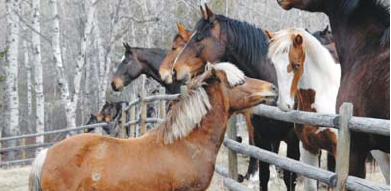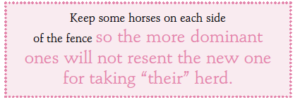Are you afraid to put new horses out together for fear of injury? Horses introduced suddenly and without sufficient preparation can cause a dangerous and costly interaction. But by taking it slow, and observing and following herd dynamics, most horses can live happily in community with friends and freedom.
Easy does it
It is always safer to first introduce new horses across an alleyway, or in two nearby (but not touching) pastures or paddocks. This way, the horses can observe and accept each other without feeling threatened. It is important to have sturdy fences and secured gates. Slip rail and swing gates should be tied to avoid mishap.
 Situate hay piles or feed buckets so new horses can eat and graze near the herd. After a week or so of calm acceptance (watch their body language for signs of interest and friendship), the horses can be placed in adjoining pastures or paddocks, with hay piles side by side. When they are ready to accept each other, horses will eat together and groom over the fence. They can then be placed together in a pasture that allows for plenty of room to escape if one horse is more aggressive. Watch closely for signs of acceptance, as horses will establish a pecking order even when they are good friends. Offering two or more hay piles is always a good idea.
Situate hay piles or feed buckets so new horses can eat and graze near the herd. After a week or so of calm acceptance (watch their body language for signs of interest and friendship), the horses can be placed in adjoining pastures or paddocks, with hay piles side by side. When they are ready to accept each other, horses will eat together and groom over the fence. They can then be placed together in a pasture that allows for plenty of room to escape if one horse is more aggressive. Watch closely for signs of acceptance, as horses will establish a pecking order even when they are good friends. Offering two or more hay piles is always a good idea.
Joining the herd
Adding new horses to existing herds is much more complicated. The new horse will have to be accepted by each herd member and work his way up the pecking order. Some horses who have been raised alone will not understand the demands made by herd members and will have a harder time than others. The more respectful the new member is, the sooner he will be allowed to join the herd.
Put the new horse in a field close to, but not adjoining, the herd’s field. When the herd has accepted having him nearby he can then be moved to an adjoining pasture. Give him a choice of hay piles – one should be at the fence line so it can be shared by him and the herd, and one should be a safe distance away from the fence line so he can eat without the pressure of the herd if necessary.
 Over time, herd members will share the community hay with the new horse and develop communication. You will begin to see the horses interact over the fence, either displaying dominance by nipping at the new horse, or friendship by standing quietly or grooming the newcomer.
Over time, herd members will share the community hay with the new horse and develop communication. You will begin to see the horses interact over the fence, either displaying dominance by nipping at the new horse, or friendship by standing quietly or grooming the newcomer.
A good way to ensure that all will go smoothly is to add herd members to the new horse’s pasture as they display friendship. The younger and less dominant horses will be first, and last to be introduced should be the lead and dominant mares.
A note of caution: keep some horses on each side of the fence so the more dominant horses will not resent the new one for taking “their” herd. One of the biggest dangers in integrating a new horse is rushing the process, and another is putting the horses together in too small a space. The process generally takes about three weeks, and even after the horses are fine in a large area it will take more time until they can be left together in a smaller space.
Watch each new situation for signs of aggression, but realize that new horses will be asked to remain on the edge for some time, and will be left alone if they respect these requests.
 A bonding exercise
A bonding exercise
If you take your time with this approach, the day will eventually come when there are only one or two contentious herd members to deal with and to put out with the new horse and the rest of the herd. At this point I get a friend to take the new horse, and I either lead or ride the dominant herd member out for a pleasant companion experience, being careful to maintain just enough distance for safety, and giving treats and congratulations upon return.
After a few of these sessions, it will generally be safe to introduce the dominant herd member to the newcomer’s pasture, but without the other herd members to contend with. If all goes well with this, the friendly members can again be added in small groups until eventually the new horse has been accepted by all.
A tale of herd dynamics
I had an interesting episode take place in my well established herd when one horse was injured. My dominant mare, who is the order-keeper and always on the lookout for a member who could possibly compromise the well being of the herd, chased the injured mare away. In the wild this would make sense, as an injured member could slow the herd down or invite predators.
It was up to me to impress upon Diva, my herd policewoman, that her behavior was unwarranted in this situation. I had blanketed Epona, the injured mare, and Diva, followed by other herd members, began to chase her relentlessly. I realized I had made Epona “different” by blanketing her, and came up with a plan to stop the persecution. I took the blanket from Epona and put it on Diva. I only left it on her a few minutes as she immediately got the point; having walked a few miles in Epona’s shoes, she gave up her vigil.
As I communicate with my herd, I continue realizing that horses have so much to teach us about being in our truth and listening to our instincts and intuition. But there are other times when I understand we have much to teach them about compassion!
Liz Mitten Ryan and her animals have co-authored four books and has developed a system of playing with horses called “Friendship And Communication With Your Horse”. One With The Herd – A Spiritual Journey has won great acclaim along with several awards. Learn more at lizmittenryan.com.







